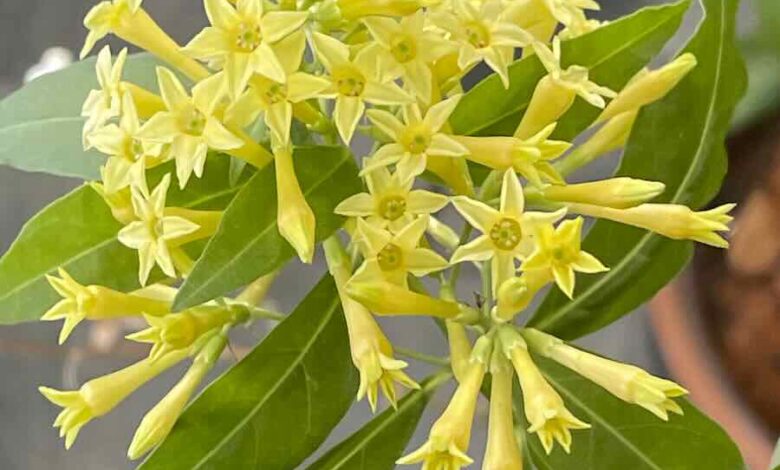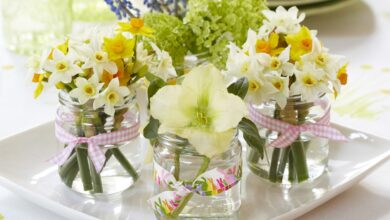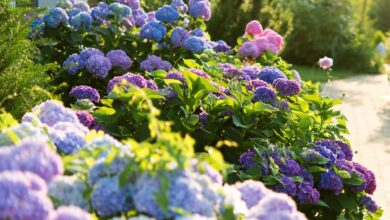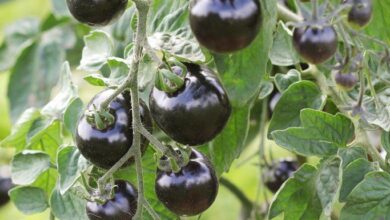
fragrant plants of the offseason, with ken druse
[ad_1]

Ken Druse encourages us to extend our season of scentual gardening. That’s S-C-E-N-T—scentual, as in fragrance, and as in the title of his book, “The Scentual Garden.” He urges us to include extra-late and extra-early garden producers and especially some indoor stars for a full year of fragrance.
Longtime friend Ken Druse, who gardens in New Jersey, is the author of 20 garden books, about the many fragrances the plant world can offer, which is our topic today. (Above, one of Ken’s fragrant favorites, Cestrum parqui.)
Plus: Enter to win a copy of “The Scentual Garden” (affiliate link) by commenting in the box near the bottom of the page.
Read along as you listen to the Nov. 23, 2022 edition of my public-radio show and podcast using the player below. You can subscribe to all future editions on Apple Podcasts (iTunes) or Spotify or Stitcher (and browse my archive of podcasts here).
fragrant plants of the offseason, with ken druse
Margaret Roach: Hi, Ken. I’m ready for some nice fragrances.
Ken Druse: Oh, I’m glad, Margaret, because I know that you have a, what is it? Lower bad scent.
Margaret: I do. I have a very perceptive little nose and so scents, if I like them, it’s fine, but boy…
Ken: Yeah, I know.
Margaret: But it’s funny because you can come inside and it’s dry and it’s hot. It’s the heating season suddenly. We didn’t have that until this past week where I am, because it was unseasonably warm. But now it’s like, well, except when you’re cooking there’s no real fragrance. Do you know what I mean? Except when you’re cooking.
Ken: Here, there is, because I’ve got a couple of bowls filled with some unusual fruits, and they smell [laughter].
Margaret: Yeah, well because you’re so clever, you always remember to have those sort of, almost like potpourri, right? The old days of potpourri and so forth.
Ken: Except these are really natural.
Margaret: Yeah.

Margaret: It’s not one of my favorite fragrances.
Ken: And we could talk about why that is, because it’s a whole big genetic thing. But I just mean in the way that cilantro, you can almost feel it. So this is a fragrance you can almost feel.
And something else that we’ve been talking about that’s so beautiful—I always get them for a bowl on the table in the fall. And then when they start to go—and they last a long time—I move them to where I got them so that they will be where they might grow, even though they’re from the Midwest and they grow here. The Osage orange, it’s also called hedge apple, and it was very popular as fence post material because the wood lasts a very long time. It’s very hard wood, and they used to make furniture out of it, outdoor furniture even. But the fragrance of these funny gnarly, they’re almost like brains and they’re gorgeous chartreuse color.
Margaret: Right. Chartreuse brains [laughter].
Ken: Yeah, chartreuse brains the size of softballs; they probably weigh almost a pound a piece. And they smell like grapefruit and ginger, but really it’s indescribable. It’s a wonderful, wonderful fragrance. [A bowl of them at Ken’s, below.]
Margaret: So that’s Maclura?
Ken: Maclura pomifera.
Margaret: Pomifera. Right.Settings
Ken: And pom- is like apple.

And above that, on the top lip of the little box with the button, there was one of these Osage oranges sitting, its green brain as you say, this hedge apple sitting there. And he said, his caption was something like, “Only at the Arnold Arboretum” [laughter]. We know when someone picked that up and put it there. But it is funny because you will see them sometimes in the roadsides by where there are some trees, you’ll see a whole crop of them on the ground.
Ken: I worked in Washington temporarily a couple of times and people hated them because they’re planted as street trees, and the fruits used to fall on cars and dent the cars.
Margaret: To go back to that Chinese quince just for a second. So that plant, where does it grow? What exactly do… Because I think quince, I think either a big shrub or a tree or something. So what does that again?
Ken: It’s a tree.
Margaret: It’s a tree. O.K.
Ken: Chinese quince. And quince—well, even the fruit quince has a very strange and wonderful kind of pear-apple smell. And quinces are still used in perfumes, including Britney Spears’s Fantasy.
Margaret: And now do you grow the Pseudocydonia? Do you grow the Chinese quince tree?
Ken: Yeah.
Margaret: O.K. And so it’s not like with the Osage orange, you find one somewhere and you grab it and use it for its… Enjoy it in its fragrant season in a bowl or whatever. So this is something that you grow.
Ken: Yup, because it’s a very beautiful tree. It has patchwork like a Cornus kousa, you know? It’s beautiful.
Margaret: The bark?
Ken: Mm-hmm. The bark, right.
Margaret: Oh, interesting.
Ken: And then it has shiny red leaves and it’s in the rose family. So I was going to say it’s shiny red leaves like a pear, but we don’t want to talk about pears.
Margaret: That’s bringing us to the… And I assume that you’re saying that these fruits are produced in the fall, so this is something that you might still be enjoying if you had had a crop and they’re still in good enough shape to have that nice fragrance.
Ken: Right, probably almost to Christmas, almost.
Margaret: Oh, O.K.
Ken: And these are not edible fruits. I know everybody wants to grow something edible, but it won’t harm you. I don’t think the Maclura, I have never tasted it, but it probably is awful. And the Pseudocydonia, the fruits are as hard as wood.
Margaret: O.K.
Ken: One year I tried to, I had a whole bunch and I tried to make jelly and I did what you do to make jelly. I think I got about six ounces of jelly [laughter] from the whole-.
Margaret: Nice. That was a good day in the kitchen.
Ken: … kettle full. They’re really hard as wood.
Margaret: O.K. That’s the fall and where we’re having the last of things. And I was thinking about, in anticipation of talking to you, I was trying to think, well what was the last wonderful scent that the garden had? And I like the smell of fall leaves, when it first all comes undone and it’s a dry day. And it’s not that I don’t like that, but-

Margaret: I don’t have one.
Ken: We have three [laughter] and different ones and we had some guests this last weekend and I can’t smell it, but people walk through the garden and they say, “Cotton candy. It smells like caramel, it smells like caramel.” And it’s the yellowing and fallen leaves of the Cercidiphyllum japonicum. But not to me, for some reason. And I can smell everything, but I can’t smell this tree. But it’s famous for its cotton candy fragrance.
Margaret: And it’s a beautiful tree.
Ken: I interrupted you. Yeah. Oh, well, we have two different weeping ones [above, at Ken’s, one of the weepers] and the species.
Margaret: No, it’s O.K. So what are its other, I mean in terms of growing it, we’re not just going to grow it for the cotton candy smell of the fallen leaves, but what are some of its other-
Ken: Well, if you think of Cercidiphyllum, the leaves are like a redbud, like Cercis.
Margaret: Like Cercis.
Ken: So it has very pretty leaves, yellow fall color. And I have two weeping ones. One is ‘Morioka Weeping,’ which goes tall and the branches weep to the ground like a weeping willow. And the other one’s called ‘Pendula.’ And it’s short, but it makes new branches and stems the whole season. So it’s sort of like Cousin It [laughter], it’s got a mop look. But then the leaves turned yellow and when we were walking through the garden, the leaves were on the ground and the guests said, “Oh, what’s that smell?”
Margaret: Any fragrance? Sorry: Any flowers? Any flowers earlier or anything?
Ken: Oh, on the tree?
Margaret: On katsura.
Ken: No, but it’s really a beautiful tree, though.
Margaret: And I should have said at the beginning, let’s do a giveaway of “The Scentual Garden,” your book, which is so gorgeous and really delves into why things smell and all the ranges of scents in the whole natural world. I mean it’s really in-depth. So throughout the year and so forth and lots of beautiful pictures.
But I was thinking about how in the fall, I know, coming up in the New Year, and sometimes for me it’s January, sometimes it’s February here in the north country. I have the Asian witch hazel hybrids that have one of the first scents of the new garden. But do the fall witch hazels, the native Hamamelis virginiana, do they have a scent? I’ve never actually gone, I have them around the edge of my property, native ones just that were there.
Ken: They have fall color, and unfortunately, or some of them—it’s weird, some of them drop their leaves so you can see the flowers, some of them don’t and the flowers are obscured. I mean individuals, I don’t know what it is. And some of the individuals have a very slight fragrance, but some of them don’t. Maybe it’s the time of day, but the fragrance is like witch hazel in the bottle. It’s not really alcohol-y, but it’s that funny clean witch hazel astringent smell, but very slight. It’s not like the wonderful ones that we’re going to have in the spring. Like the hybrid x intermedia types and also the native vernalis. And that’s like spring right, vernal? Do you have any?
Margaret: I don’t have any vernalis, no.

Margaret: I have a few of the intermediate, the Chinese-Japanese witch hazel hybrids, that again bloom just after the New Year here. And they have a sweet fragrance. I’ll have to check in January, February and see if it’s Juicy Fruit gum for them, too. But yeah.
And then of course, so that’s the other end. We just closed out the season, and we were talking about some of the things that had scent. And then when it begins, even before the main event of the growing season, that many of us know what we love about, what fragrant plants we love-
Ken: The flowering bulbs, for example.
Margaret: Right, right, right. So really, then it starts to really—lots of possibilities. But what about the offseason [laughter]? In the north, we’re indoors now a lot. So any hope?
Ken: Well we were talking about smells we like and smells we don’t like. And you made me think of paperwhite narcissus, because so many people give it its own room because they hate the smell so much. And it’s kind of a perfume, but it’s just too much.
It’s got a chemical compound in it, that’s the reason it’s unpleasant. But I’ve grown a couple of varieties. One’s ‘Inbal,’ maybe you’ve seen that. And ‘Wintersun’ is another one. And they’re not the giant Israeli ones. And the fragrance is much softer, so that’s possible. And it’s great to force them, it’s so easy. They don’t need chilling or anything. You just put them in some water between November and January, and then they bloom.
Margaret: Yeah, that’s interesting that some are less intense scented because I definitely don’t like the super. And that chemical, is that the chemical indole? Is that how you say it? I remember that from your book.
Ken: It sort of smells like, politely, mothballs, but it’s actually in excrement. So the reason people are sensitive-
Margaret: Wait, that’s what that means? That’s what that means?
Ken: Indole. I don’t know how it got-
Margaret: Oh, but that’s what it smells like. It’s just-
Ken: To me it smells, I’m going to tell you what it, it smells like old urinal cakes, which you’ve probably never smelled [laughter].
Margaret: No. Being a girl and all, but yeah, that’s right. Exactly. So yeah, not good. Not good.
Ken: Not good. But it’s actually in some perfumes, they put it into it, because from a distance in very small amounts—it’s in almost every daffodil. It’s wonderful, it’s sweet, but too much of a good thing is too much.
But right now in the sunroom, the citrus have started to bloom, which is early. They usually start in January, February. And orange blossoms, lemon blossoms, they’re thick. But that’s a wonderful fragrance. Do you grow any citrus at all?
Margaret: I never really have. And I was at a friend’s and neighbors the other evening and they have two giant ones that they’d hauled in from outside. Then they put them out in the growing season and they have them in their living room. The pots are almost hip with the thigh high. And I don’t know if they’re 24-inch wide pots; they’re really big. And they’re trees—I mean, these are trees. One is a lime and one’s a lemon. And the lemon, especially, it was covered in fruits. They weren’t yellow yet, but it was covered in fruits. And I was like, “What did you do?”
Ken: Yeah, I was going to ask you that, “What did they do?”
Margaret: “How did you make this…” They said that they’ve had a lemon for five years. Again, they put it outside in the garden in the growing season. But then it comes in, and it’s in a south window. It’s in their living room, so it’s not like it’s super-cool or anything.
Ken: Or humid.
Margaret: Right. And they said that they give it, or maybe once a month they give it some fish emulsion, I guess pretty much year round, which is not a super-hot lot of fertilizer or anything. And that, I guess during the growing season, they had given it maybe one of those plant spikes or something, some type of fertilizer stick kind of thing that you put in the soil that was meant for, rated for citrus. And I don’t know the brand, which I could try to find out. And they water judiciously, a little sparingly in the offseason. But boy, I was like, “Wow, this is amazing.” [Laughter.]
Ken: Do you remember if it was flowering and fruiting at the same time?
Margaret: It was not fruiting, excuse me, flowering right now. But I have been there where, in other years where there was this beautiful scent in the living room as well as fruit still hanging. Yes.
Ken: Well, that lemon was probably Meyer lemon-
Margaret: I think it is a Meyer. Yes. Yes.
Ken: Which is, I guess it’s a hybrid of a [mandarin] orange and a lemon. And if you have to try to grow a citrus, that’s the one to grow. It’s really the most forgiving and the easiest to grow to get fruit. And if you’ve got a south window, oh boy. And if it’s cool in the winter, oh boy. And if you can summer it outdoors, it’s possible to have your own fruit. And the fruit smell wonderful, too.
Margaret: Oh, yes.

Margaret: Yeah. Well, only that you’ve shown me, but yeah.
Ken: At Wave Hill they have wonderful ones. The fruits look like—they’re big and they look like octopuses because they have all these tentacles, and there’s no moist fruit to eat. It’s all pith inside, but that’s another one. You can cut that and put it in a bowl and for a month, you’ll have a beautiful, beautiful fragrance, which is sweet perfume-orangey. But it’s great.
Margaret: So maybe try citrus, huh? I might do this, I might try this and see what happens. Because there’s just something so, I don’t know. It’s like having not just fragrance, but a harvest in the winter. Do you know what I mean?
Ken: Yeah, of course.
Margaret: It so much completes the year, which is great.
Ken: What are they going to do with all those lemons?
Margaret: They’re very interesting. They cook a lot. And one of the two, he makes sorbets and stuff. They make ice cream, a lot of baking, jams, jellies, whatever. And actually we had some lime sorbet after our supper [laughter]. So I guess if life deals you lemons, make sorbet, right? Is that the deal?
Ken: [Laughter.] Absolutely. I’m so glad to hear that they used them because-
Margaret: Yeah, absolutely. Yeah, they love them, yeah. So what sort of other house plants that you would say we could give a try if we want some indoor fragrance?
Ken: Well, I have a houseplant that’s related to something you and I both experienced [laughter]. It’s a kind of Cestrum.
Margaret: Uh-oh, I know what you’re going to say.
Ken: But Cestrum parqui [photo, top of page] doesn’t smell like Cestrum nocturnum. It’s a much lighter scent. But they’re really great, and flowers are yellow. And the great thing about it, it’s never out of bloom. This thing blooms always. It’s always in bloom and it only smells at night, so it’s in the sunroom. I don’t smell it unless I go and find it. And as I said, I actually think that the Cestrum nocturnum smell is, well, it’s more perfumy and it’s certainly strong. And we guess that since it was related to peppers and Solanum plants, is that right? Solanaceae-
Margaret: Yeah.
Ken: …plants in the pepper family that maybe the molecules in the air could be dangerous to someone who’s sensitive.
Margaret: Well, because you and I, just so people know why you’re saying I’m sensitive to it is because a million years ago we were at a dinner party. It was actually out on a terrace, but the plant was right close to the table.
Ken: A big plant with lots of-
Margaret: And as the evening came on, the night-blooming jasmine, Cestrum nocturnum did its thing and I almost did my thing for good [laughter].
Ken: Yep.
Margaret: That was almost the end of Margaret.
Ken: We had to escape.
Margaret: I always wondered about, this is a total aside, but some of the lilies that people, including floral arrangements and so forth on a dinner table, some of them are just so perfumy to me, some of them.
Ken: And you can’t taste the food.
Margaret: No, exactly. And that’s what, it spoils it too. Even if it doesn’t make you sick, it makes me kind of wheezy. But anyway, so is this Cestrum parqui?
Ken: P-A-Q-U-I-I. [Update: It’s parqui, Ken realized after the taping.]

So what about true jasmines? Because that’s not a true jasmine, even though the common name is jasmine, right?
Ken: Right. Well, I very much like and also can grow Jasminum sambac [above, at Ken’s] and the one that everybody has is ‘Maid of Orleans.’ There’s lots of different selections and double ones. I can’t grow any of the other ones. But Jasminum sambac ‘Maid of Orleans,’ little flowers and the fragrance is jasmine, but it’s not that deep lily-like fragrance of some of the jasmines. It’s a very warm, high fragrance. And for me, it never has more than—well it might have 10 flowers, and they’re tiny. They’re smaller than dimes probably. But I love that smell.
Margaret: Is it like a viney thing or what’s-
Ken: No, it’s shrubby.
Margaret: Shrubby, and so does it get very big? I’m trying to visualize how-
Ken: Well it doesn’t get big for me. And it’s not a pretty plant. It has O.K. green leaves, but I don’t have a south window like some people, so everything here is kind of leggy, and a branch goes one way and a branch goes another way. And I’m after flowers, so I just want to keep all those flowering parts going. And it doesn’t bloom year-round, it blooms mostly in the spring and summer. But that’s a really nice fragrance. I used to grow Jasminum, I think it was grandiflorum, which is the one that’s in Chanel No. 5. Oh. And that’s a vine. Vine-
Margaret: And that’s why I asked, because in my head I had jasmine is a vine and visualizing vine. So I must have…
Ken: And the flowers are bigger and they’re like—I was going to say spiders. Well, they’re stars and they have lots of little points and very different looking flower.
Margaret: So I have to just know, can I possibly grow a gardenia [laughter], because… Can I do that? Have you ever? Do you succeed with them?
Ken: I think you could. Can you grow rosemary?
Margaret: You mean indoors in the winter? Yeah, I have one cool kind of a mudroom with good windows. Yeah.

Probably if you had a cool place, you could ignore it a bit. Probably. It’s probably too much care is what gets them. And now there’s a lot of different ones. There’s even “hardy ones” to like Georgia, a few different kinds. They say Zone 7, but you know they say stuff. They.
Margaret: Yeah. Yeah.
Ken: People telling them-
Margaret: The authorities.
Ken: … We’re not in Zone 7, but I know that there are some that are hardier now. But you can grow them. I don’t know if you’d want to grow them.
Margaret: Yeah, give it a try.
Ken: It’s strong.
Margaret: Oh, O.K. It might be too much for me. No, it’s just, it’s that kind of a thing that we’ve all heard about them, and seen them, and it’s aspirational or whatever because-
Ken: The ones you would grow as a houseplant or in a greenhouse if you weren’t in production, the flowers are like an inch and a half. They’re not like those gigantic ones that you can sometimes get at a florist that are 3-1/2 inches across and then they turn yellow and you can float them in a bowl. It’s a very nice gift, I’d say, birthday gift for someone. One flower.
Margaret: Well, I’m going to strive for a year of scent, thanks to Ken Druse, author of “The Scentual Garden.” Thanks, Ken.
(All photos by Ken Druse.)
enter to win a copy of ‘the scentual garden’
I’LL BUY A COPY of “The Scentual Garden” by Ken Druse for one lucky reader. All you have to do to enter is answer this question in the comments box below:
Do you have any fragrance in your life from a plant this time of year? Tell us more.
No answer, or feeling shy? Just say something like “count me in” and I will, but a reply is even better. I’ll select a random winner after entries close Tuesday November 29, 2022 at midnight. Good luck to all.
(Disclosure: As an Amazon Associate I earn from qualifying purchases.)
prefer the podcast version of the show?

[ad_2]






